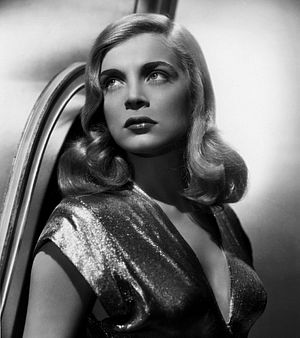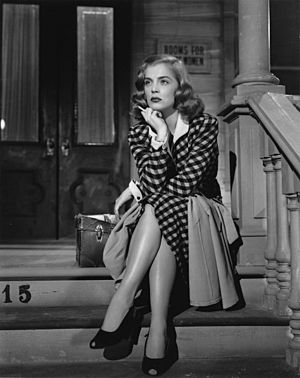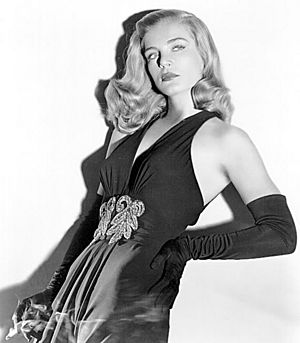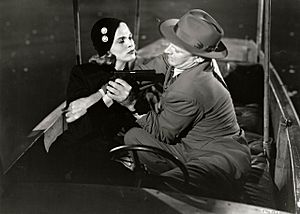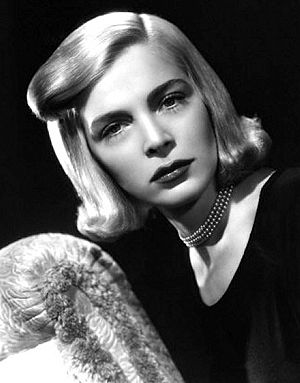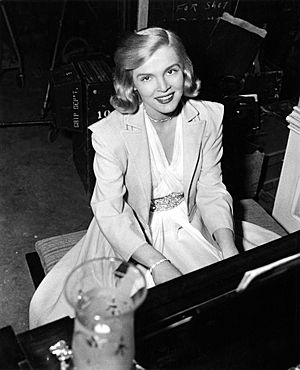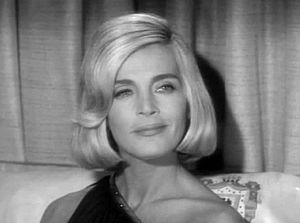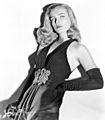Lizabeth Scott facts for kids
Quick facts for kids
Lizabeth Scott
|
|
|---|---|
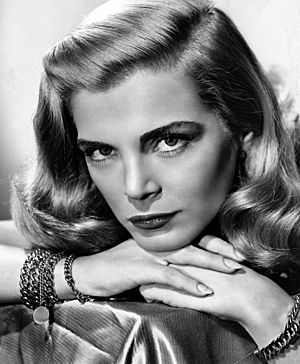
Scott in 1947
|
|
| Born |
Emma Matzo
September 29, 1921 Scranton, Pennsylvania, United States
|
| Died | January 31, 2015 (aged 93) Los Angeles, California, United States
|
| Other names | Elizabeth Scott |
| Occupation |
|
| Years active | 1942–1972 |
| Signature | |
 |
|
Lizabeth Virginia Scott (born Emma Matzo; September 29, 1921 – January 31, 2015) was an American actress, singer, and model. She was known for her unique "smoky voice" and was called "the most beautiful face of film noir" in the 1940s and 1950s. Film noir is a style of dark and moody crime films.
Lizabeth Scott starred in many movies, including The Strange Love of Martha Ivers (1946), Dead Reckoning (1947), and Too Late for Tears (1949). Out of her 22 films, she was the main character in almost all of them. She also performed on stage, radio, and television.
Contents
Early Life and Beginnings
Emma Matzo was born in Scranton, Pennsylvania. She was the oldest of six children. Her parents were Mary Penyak and John Matzo. The family lived in Scranton, where her father owned a market. Her father was a "lifelong Republican", which is a member of one of the two main political parties in the United States. This influenced Lizabeth's own views on business and money.
Lizabeth went to a Catholic girls' school called Marywood Seminary. Later, she moved to Scranton's Central High School, where she acted in several plays. After high school, she worked with a theater group in Newfoundland. She also worked at the Barter Theatre in Abingdon, Virginia. She then attended Marywood College for six months before leaving.
In 1939, when she was 17, Lizabeth moved to New York City. There, she became a model for the Walter Thornton agency. She chose her stage name "Elizabeth Scott" after reading a play called Mary of Scotland. Later, she dropped the "E" from Elizabeth to make it more memorable.
Starting Her Acting Career
In late 1940, Lizabeth auditioned for a traveling show called Hellzapoppin. She was chosen from hundreds of women. This was her first professional acting job, and she was known as "Elizabeth Scott." She toured 63 cities across the United States for 18 months, performing short comedy acts.
Lizabeth returned to New York in 1942. She starred in a play called Rain in an "off-Broadway" theater. This means it was a smaller theater than the famous Broadway ones. It was her first main role. A Broadway producer named Michael Myerberg saw her performance.
Myerberg hired Lizabeth to be the understudy for a famous actress named Tallulah Bankhead in a new play called The Skin of Our Teeth. An understudy learns a role so they can perform if the main actor cannot. Tallulah Bankhead was not happy about having an understudy. Lizabeth said that Bankhead "never spoke to me, except to bark out commands." Lizabeth never had to fill in for Bankhead during this time, but her presence made sure Bankhead showed up for her performances.
Later, another actress, Miriam Hopkins, took over the role. Lizabeth liked Hopkins more but was still sad she didn't get the main role herself. She eventually quit the play. However, she did get to play the main role of Sabina for one night when the new actress, Gladys George, was sick. A film producer named Hal B. Wallis heard about Lizabeth's performance that night.
Becoming a Star in Hollywood
Working with Hal B. Wallis
A New York writer named Irving Hoffman introduced Lizabeth Scott to Hal B. Wallis. Wallis was a very important film producer for Warner Bros.. He arranged for Lizabeth to have an interview. Lizabeth then got an offer to star in the Boston version of The Skin of Our Teeth. She chose to go to Boston. On the train, she decided to drop the "E" from her name, becoming "Lizabeth Scott."
Lizabeth then moved to Los Angeles. She did a "screen test" at different studios. A screen test is a short film to see how an actor looks and acts on camera. Hal Wallis saw her test and believed she had great potential.
At 22, Lizabeth Scott made her first movie, a comedy-drama called You Came Along (1945). Hal Wallis told a reporter that her "eyes are alive and sparkling" and her "voice makes her intriguing."
Her First Big Films
In 1946, Lizabeth starred in The Strange Love of Martha Ivers. This was her first film noir movie. Film noir often features mysterious women and dark stories. Lizabeth played Antonia "Toni" Marachek. Hal Wallis was very keen on making Lizabeth a big star. He even added more scenes of her in the movie.
In June 1946, Lizabeth Scott became the first Hollywood star to visit Britain after World War II. She went there for the premiere of Martha Ivers and to promote the film.
When she returned, she joined the cast of another film noir, Dead Reckoning (1947).
Lizabeth's name and picture were shown equally with Humphrey Bogart's on the movie posters. This showed how important she was becoming. Many publicity photos showed her in a famous gown from the movie. People thought she was a very promising new star. However, this movie also made her known for playing "hard-boiled" characters, a type of role she would often play throughout her career.
Later 1940s Films
Lizabeth continued to play strong characters. She starred with Burt Lancaster in Desert Fury (1947), which was one of the first film noirs made in color. She also appeared with Lancaster and Kirk Douglas in I Walk Alone (1948), a story about betrayal.
Lizabeth played a different kind of role in Pitfall (1948), which she said was one of her favorite films. She also starred in Easy Living (1949).
Lizabeth played a classic "femme fatale" (a mysterious and dangerous woman) in Too Late for Tears (1948). Many people consider this her best film and performance. Even though it didn't do well at the box office at first, film historians now see it as a great film noir.
In 1949, Lizabeth legally changed her name from Emma Matzo to Lizabeth Scott, the name she had been using professionally for years.
1950s Films and Music
Lizabeth made several films in the 1950s. She tried to play different types of characters to avoid being typecast. In The Company She Keeps (1951), she played a probation officer. She also played a "torch singer" (a singer who performs sad or romantic songs) in Dark City (1950), which was Charlton Heston's first movie.
Lizabeth also appeared in a Western film called Red Mountain (1952). She returned to Britain to film Stolen Face (1952), a film noir that was similar to Alfred Hitchcock's later movie Vertigo.
She tried comedy again in Scared Stiff (1953) with Dean Martin and Jerry Lewis. Lizabeth played an heiress who inherits a haunted castle. Even though she found filming difficult at times, she later said it was one of her favorite movies.
Her last film under contract with Paramount was Bad for Each Other (1953). After this, Lizabeth became a freelance actress, meaning she could choose her own projects. She later said she decided she didn't want to make films anymore, but she did make three more: The Weapon (1957), Loving You (1957), and Pulp (1972).
Music Career
Lizabeth Scott had a beautiful voice and trained with famous voice teachers. She had a vocal range of two octaves, which is a wide range for a singer. She planned to start a career as a torch singer in nightclubs.
She came out of retirement to appear in Loving You (1957), which was Elvis Presley's second musical movie. Lizabeth was very fond of Elvis during filming. Even though she had trained her voice, the studio decided to have someone else dub her singing voice in the movie.
Despite this, Lizabeth signed a recording contract and released her own album called Lizabeth in 1957. It included 12 songs, both torch songs and romantic ballads. She made her public singing debut on a CBS television show in 1958.
Television Appearances
In the 1960s, Lizabeth Scott appeared as a guest star on several television shows. She was in an episode of Adventures in Paradise called "The Amazon" (1960). She also appeared in a fun episode of Burke's Law (1963). During this time, she also took classes at the University of Southern California.
Personal Life and Later Years
Lizabeth Scott was known for keeping her personal relationships private. She dated several well-known people, including Van Johnson, James Mason, and Peter Lawford. She was briefly engaged to an architect named John C. Lindsey in 1953.
In May 1969, it was announced that Lizabeth was going to marry oil executive William Dugger. He passed away suddenly in August 1969.
Lizabeth made her final film appearance in Pulp (1972), a comedy noir with Michael Caine. The director had to convince her to come out of retirement for the role. Although she enjoyed filming, many of her scenes were cut.
After Pulp, Lizabeth Scott mostly stayed out of the public eye. She worked in real estate and volunteered for charities like Project HOPE. She was also a major donor to the Ancient Arts Council of the Los Angeles County Museum of Art.
Lizabeth Scott was a private person but not a complete recluse. She remained friends with a close group of Hollywood insiders, including the singer Michael Jackson. She also spoke fondly of Hal Wallis at a tribute event in 1987. A film historian interviewed her in 2003, and she could still recite her opening lines from The Skin of Our Teeth, a play she had learned decades earlier.
Lizabeth Scott passed away on January 31, 2015, at the age of 93, from congestive heart failure.
Lizabeth Scott has a star on the Hollywood Walk of Fame at 1624 Vine Street, honoring her contributions to film.
Filmography
Images for kids
See also
 In Spanish: Lizabeth Scott para niños
In Spanish: Lizabeth Scott para niños


